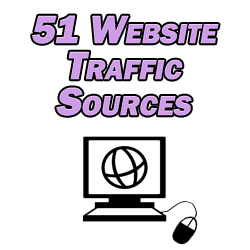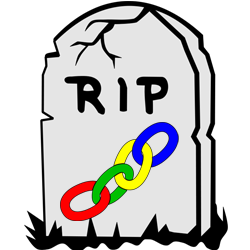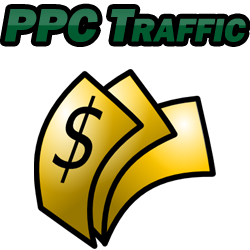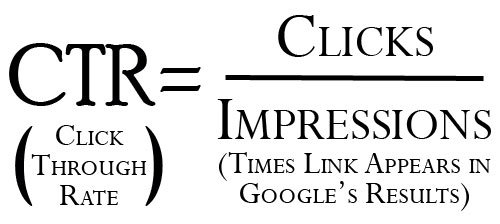Traffic is the lifeblood of any website. Without traffic, well you might as well not have a website. As such, I’ve put together the definitive, ULTIMATE list of 51 website traffic sources. No doubt you’ve heard of some of these, but I guarantee there will be plenty you’ve never considered but could bring in a flood of targeted traffic.
Let’s not waste any more time, let’s get into my 51 website traffic sources, breaking them up by category.
51 Website Traffic Sources
Organic/Search Engine Traffic Sources
1 – Organic/Search Engine
Let’s start with the most obvious of the website traffic sources and probably the one that brought you here: organic.

No sneaky tricks here to pad my numbers; I’m lumping Google, Bing, etc. all into one here.
One of the most difficult but arguably the most valuable of all sources of traffic is from Google itself. There’s a certain level of built in trust and suggested authority a page gets from ranking well in Google.
I’ve obviously made it my business over the last decade and certainly the focus on this site.
If you want to rank #1 in Google, sign up for my free Rank Climber’s Bootcamp (signup form at the top right).
I cover everything you need to know there, including definitive guides on keyword selection, on page SEO, improving CTR to get people clicking through to your web page in Google, improving site speed and compatibility, getting backlinks, local SEO, and much more.
2 – Google Images
Let’s not forget the importance of alt tagging your images properly. I like to save my images with keyword rich file names then replicate that in the title and alt tags of that image when applicable.
This is a free bonus source of traffic as that image can then rank independently for its keyword and bring people to your site.

For original images which you spend more time on like infographics, be sure to include your branding/URL as a watermark on the image somewhere in case people download and share your images.
3 – Internal Links
A lot of webmasters forget the importance of this, but keeping that traffic on your site once it’s there is just as important as getting them there.
The more time someone spends on your site, the more likely they’ll return in the future.
Therefore make sure that you’re effectively keeping people on your site by linking to other relevant pages.
You can do this by simply inserting a link in the copy of your page to another page.
You should also offer a couple of relevant articles at the end of your article. There are plugins which do this, or a lot of themes have it built in, as well. It’s set and forget easy, and it keeps people on your site.
Content
4 – Earn Links Through Content/Link Bait
I have to get this one out of the way, as well, because it’s one of the major sources of traffic for my websites.
The idea is simple: you create quality content which other webmasters want to link to, exposing your site to their audience.

This can be in the form of something specific like a free tool or infographic, or it can just be a really informative and helpful article (like say, 51 website traffic sources).
Basically something which people want but can only or at least more easily get on your site.
Short of cold emailing another webmaster to tell them about that amazing new resource you just put on your website (I mean, you CAN do this if said resource is good enough), you can simply use many of the other methods covered in this list to get people to see your content/link bait.
This is a list of website traffic sources, after all.
The point is to begin with good content, otherwise the rest of your efforts will be in vain to some extent.
5 – Give Away Branded Resources
Creating something which is simple to make yet has value like an informative infographic or PDF formatted eBook on your topic and encouraging your peers to share it with their contacts can net you a ton of traffic, depending on how many people see it.
Just be sure to put a watermark on the infographic with your website name and URL or even live links back to your site in the case of the eBook. You can share it on any of the dozens of sites and services I’m going to share throughout the rest of this list.
Infographics also rank well in Google images and can appear in the normal SERPs, as well.
All of this goes back to not only making a useful infographic but optimizing its tags and being sure to include a highly visible watermark with your URL for branding.
6 – Finding Websites in your Niche With Dead Links
A technique I’ve been doing for years to earn links and their associated traffic involves dead links. Dead links are basically links on a website which lead to pages which are unresponsive.
Google hates pages with dead links on them because people hate dead links. As such, having a page which links to dead pages hurts your rankings.

Why am I mentioning this in an article about website traffic sources?
Because you can find dead links on a site, then reach out to the webmaster letting them know and offering a relevant page of yours as the replacement.
Many webmasters are just grateful for the help and your easy solution and will give you the earned link.
You can use a free tool like Dead Link Checker (speaking of a site earning a link for a free and useful resource) to search websites in your niche which would have relevant links to send your way.
Not only will this net you whatever traffic that formerly dead link was sending, but it’s a potentially valuable link which will boost your rankings.
Rinse and repeat for hundreds of websites in your niche and you’ll be outranking them all and enjoying the traffic which comes with it.
Don’t forget to check your own site while you’re at it to make sure YOU don’t have any dead links.
7 – Guest Blogging on Another Site
Another good old fashioned networking tool, this is still a great way to get your content in front of a new audience.
Reach out to other webmasters in your niche and ask them if you can write a post for them. To raise your chances of success, give them a brief overview of what you have in mind. Make sure it’s super relevant to their audience, as well.

Guest blogging is a win-win for all involved. They get a free piece of quality content on their site and you get exposure in front of their audience.
8 – Inviting Guest Bloggers on Your Site
Like I just said, guest blogging is a win-win no matter which way you slice it.
Another example of this is when you invite other webmasters in your niche to write content on your site.
Oftentimes the webmaster will share the post with their audience.
Whether they share it on their site or on social media, this is a sneaky way to get your site in front of a new audience. Plus it nets you some free, quality content on your site, as well.
9 – Blog Commenting
This is one of those things which used to be more effective and popular, but it got abused and consequently nerfed.
While most sites allow commenting, only some allow you to link back to your site either in the comment or in your profile. And while you almost definitely won’t get any link juice from it, the traffic is still worthwhile.
Your best bet will be to focus on one or two of the highest trafficked sites in your niche and become a regular presence there.
Just make sure that your comments add something to the discussion and you come across as an authority on the topic. Otherwise no one will be moved to learn more about you and visit your site.
Email Marketing Website Traffic Sources
10 – Your Email List
Have a list? If you answered no, you’re leaving a lot of traffic and consequently money on the table.
I actually debated putting this first on this list of website traffic sources because any traffic your site receives without having a way to collect emails is a missed opportunity.

An email list is the most reliable way to maintain contact with visitors to your website.
If you have a list already, ignore all that shaming I just did and send out an email to them whenever you put up a helpful new article or resource on your website.
It’s the closest thing to push button traffic when you send that email, and best of all it’s free! If your site is well monetized (see how to monetize your website), it’s like refilling a cash card every time you send out an email.
Just make sure you have a highly visible and enticing signup form on your site to collect addresses.
To maximize your sign up rate, offer a free resource (similar to the link bait idea) in exchange for signing up for your list. Incentivizing people to sign up is the best way to see your sign ups skyrocket.
I’ve used and can recommend Mailchimp, Mailerlite, and Aweber as options for email marketing providers.
I’m putting together a full overview on everything related to email marketing, and I’ll link to it once it’s finished here because it is so essential for virtually any website.
11 – Paid Blasts
Here the idea is to get your best content in front of someone else’s massive email marketing audience. You can essentially pay a flat fee to advertise a one-off on someone else’s email list.
You pay the fee, then the list owner mentions and links to whatever of yours you want in an email to their subscribers.
Obviously you want their audience to overlap with yours as closely as possible otherwise you’re wasting your time. That and the list owner might not let you advertise if it’s not relevant to his audience somehow.
You obviously want to advertise your best content if you go this route. If you have the kind of link bait discussed earlier, that’s what you want the owner to link to.
Some list owners have 5 and 6 digit subscriber counts, and while it can run expensive, it can be the wisest investment you’ve ever made if you have the content to back it up.
And whatever you do, make sure YOU have an email list in place to have a chance to collect emails yourself when that flood of traffic comes in.
12 – Ad Swaps
Here the concept is similar to the paid blast idea, only it’s free. The requisite here is that you have a decent sized email list and can find another webmaster with a similar sized list in your niche.
Then you both send out an email to each other’s lists to promote your respective sites, lists, etc.
That’s a practical and powerful example of the value of networking.
Social Network Website Traffic Sources
13 – YouTube

YouTube is the still the king of video marketing. It’s also second only to Google itself in terms of the most heavily trafficked websites.
Create videos out of your best articles and upload them to YouTube. This can be as simple as narrating the article itself on or off camera and putting a few graphics up alongside it.
There’s plenty of free options for video editing software out there which will let you easily create professional videos based on your existing content.
Then optimize the video on YouTube to rank #1. (I put together a complete guide on SEO for YouTube, to help you do just that, btw.)
Embed the video itself within the article you pulled it from on your site for a nice mutual boost, as well.
14 – Twitter
Twitter has a huge audience and it’s easy to leverage it to get clicks back to your site.
Build up a constant presence on Twitter and let your personality shine through what you’re writing to build a following. Share videos and images to stand out from the rest.
Make sure to use broad hashtags which relate to your niche as this helps people find your tweets. With roughly 300 million regular users on Twitter, there is an audience searching for the same content you’re creating.

The fastest way to get impressions/exposure on your tweets is to use popular or trending hashtags.
Find out what’s trending in the moment with the “Trending” section of Twitter. Find something there which can relate to your niche somehow, and either write something about that specific topic or work it back to something you’ve already written.
Then tweet about that with that hashtag and a link back to your site.
Trending hashtags can get thousands to hundreds of thousands of people searching for them.
Twitter is by no means a reliable or steady traffic source, but coupled with the right tweet or freebie (like the link bait I mentioned earlier) you can earn a ton of traffic just by paying attention and tweeting the right thing at the right time, enjoying a bit of that runoff attention.
At the very least you can earn some followers who will see your subsequent tweets. Kind of like a lower quality email list but still potentially very valuable.
15 – Facebook
Facebook can be a good place to find your audience.
Start off by creating a page for your website/business if you haven’t already. Fill in the relevant information including a link back to your site. Then toss up a banner to make it look professional and branded, and start making some posts.

You can create a post linking to an article on your site everytime you publish one. Just make sure to publish some unique content there to make it more personable, otherwise it will just seem like a robotic RSS feed for your site.
If you have an existing pool of friends, you can share a link to your website and ask them to share it with their circles.
If like me you’re not a fan of bugging your contacts like that, keep in mind that Facebook has groups for virtually any topic including yours.
Find relevant groups and add to the discussion, posting in that group as your page. Over time you’ll be seen as an authority in that niche and people will visit your page and subsequently your website.
16 – Instagram
Instagram is all about media and is second only to Facebook in terms of user numbers. Share engaging content on this platform of roughly 1 billion users in the form of images and videos.
It’s going to make more sense for some webmasters/niches/businesses than others. But if you are in any kind of niche which lends itself to images (DIY projects, food, photography, fashion, etc.), Instagram can be a natural home for your content and a great way to get some extra traffic back to your site.
17 – Quora
Yahoo Answers is dead, but sites like Quora still exist to share information.
You can even post links in your responses to questions as long as its relevant. So search for questions and topics related to your site and respond linking to a relevant article on your site if it makes sense.
18A – Forums

Forums are still wildly popular in some niches. Just search in Google for your niche + forum.
Apply the same ideas as I mentioned in the Facebook section like with pages.
Make it a point to answer questions and engage in discussion for a few minutes every day over breakfast or before bed.
Most forums allow a link back to your website in your signature, so make sure you have that in place. After some time, you’ll be seen as an authority in that niche and people will begin clicking through your signature links with greater frequency.
This is an especially targeted and therefore more valuable traffic source.
18B – Create a Forum
On the topic of forums, the only thing better than frequenting a forum and sharing your knowledge and building your reputation is having your own flourishing forum on your own website. In that instance, not only are people coming to your website for knowledge, but to communicate with others in the community.
There are plenty of free plugins and themes in the case of WordPress to facilitate creating a forum on your website. Note that while it’s not complicated or difficult, it’s a lot of tedious work to create a forum on your website.
Not only do you have to create the forum, but you’ve got to create a worthwhile community there.
If you’ve got the work ethic for it and are willing to spend a lot of time there in the salad days to get your user numbers up until the community can survive without your constantly pushing the discussion, it’s a great source of traffic, and potentially one of the biggest sources possible.
19A – Discord
If you’re not familiar with it, Discord is kind of like a live forum/chat room. The “forums” in this case are called channels, and there’s a channel about literally anything you can think of.

Create a branded username and find relevant channels to your niche to join. Most of these channels you need an invite just to prove that you’re not a bot. Once you’ve been accepted, engage in the discussion. Generally links are allowed, but like with any other medium, spam is not tolerated. Make sure you’ve got a reputation before you start mentioning and or linking back to your site.
If you’ve got good credit on a channel which has a lot of eyeballs on it, this can net you a lot of targeted traffic.
19B – Create a Discord Channel
Just like the forum idea, I’ll separate this into its own source because it’s obviously a very different thing.
Creating a channel on Discord is quick and simple. Once you’ve created the channel, create an evergreen invitation link which never expires to it. Then take this and create a custom link via a free plugin like Pretty Links.
Basically it would look like “example.com/discord”. Just replace “example” with your site and there’s your attractive link which redirects to your Discord. You can include this link with your social media links you post everywhere including on your site.
While the traffic doesn’t exist on your website like with creating a forum on your site
One more note is that you can create channels within your Discord channel. I recommend creating a few channels to do a lot of the heavy lifting for you like a “Rules” channel, a “Welcome” channel, etc. You can add additional channels based on different topics within your niche as you get more users to the channel.
Just like with creating your own forum, the challenge is building an empty channel into a community, so be prepared to spend a lot of time there in the early days to encourage people to spend more time there themselves.
20 – LinkedIn
LinkedIn is mostly thought of as a platform for job searching and networking. You can create a profile for your business/website and post content from your site to the network.
This is a great place to build your credibility within your niche amongst your peers, as well.
As such this makes it a great place to attract links from webmasters in your niche who want to share your content they saw on LinkedIn with their audiences.
21 – TikTok

TikTok is massively popular, and it’s all about short videos. You can actually spin an article into a lot of content on TikTok.
If you have a “10 Tips…” article (for example), you can make a series of ten 60 second-or-less videos, one on each tip. This makes regular video uploads a lot easier. Heck, I could get 51 out of this article alone!
22 – Vimeo
Vimeo isn’t nearly as popular as YouTube. Still it’s another good place to publish your existing videos for a little traffic bump with little effort.
23 – Twitch
Twitch began as a game streaming platform. Now people use it to stream anything and everything. You can use it to do regular streams where you talk about your niche through webinars and presentations. Over time you’ll develop an authority presence and audience along with it.
You can add links to your profile to point back to your site along with a branded profile image or video when you’re not live to point people back to your site.
24 – Reddit
Reddit is one of the best places to share information with people. It’s kind of become the authority spot for getting quick answers to questions because there are so many users.
With over 1 million subreddits (specific, niche based forums), there’s an audience for anything. Find yours and become a presence there, answering questions and weighing in on discussions like anywhere else and linking back to your content when applicable.
Just note that self promotion is closely monitored in most subreddits so be smart and don’t set out to sell or spam.
25 – Pinterest
Pinterest is worth mentioning because of its huge user base and referral upside. The audience is primarily 25-40 and is heavily female skewed, so keep that in mind if your audience overlaps.
26 – Patreon
This is a site/service where people can financially support their favorite content creators.

Basically the idea is to create a Patreon for whatever type of content you create. You can create incentives to get people to support you on there. This can be unique content which people can’t get anywhere else.
Once it’s set up, link to your profile on your website and promote it anywhere else you promote your content. The best places to promote this involve your most targeted traffic (email list or your forum or Discord if you have one).
Patreon isn’t directly a fresh source of (new) traffic mind you. I kind of liken it to your email list in a way.
This is where your most loyal supporters will gather, even more so than your email subscribers because these people donate money to you each month to support what you do.
Patreon is about developing your existing traffic into even more loyal and valuable traffic. This can pay dividends as these people are more likely to share your content with other people. In that way, it can become a fresh source of traffic. If you’re willing to put the work in to create the bonus exclusive content, it can be another nice source of revenue, as well.
27 – Slideshare
Slideshare is a site where you can share presentations, infographics, videos, etc. You can take your best articles from your site and repurpose them into slides and share them here. This is a great place to share those branded/watermarked infographics I mentioned earlier. Encourage people to download and share them and the traffic will begin to come in without lifting a finger.
PPC Advertising
28 – Google Ads
Boo! No one wants to pay for traffic, I get it. But PPC traffic has the advantage of being both instant and insanely targeted if you know what you’re doing.

Google’s ad network is massive. It allows advertisers to promote whatever they want across websites as well as Google’s flagship properties.
This includes their SERPs (search engine results pages) and YouTube to rattle off two big names right there.
29 – Facebook Ads
The beauty of Facebook Ads is that it can find the most targeted and therefore valuable traffic. This is because Facebook users share ridiculous amounts of personal data about themselves on the network.

Facebook’s ad platform lets advertisers take advantage of this to find their exact audience.
So while the danger with a lot of PPC advertising is wasting your budget by showing your ads to the wrong audience, that’s not an issue with Facebook.
30 – Bing Ads/Yahoo Search Marketing
Same stuff, different networks. Let’s move on.
31 – Advertising on Another Site
While not strictly PPC, you can rent ad space on someone else’s site for a time to advertise your site, product, email course, etc.
A lot of webmasters in your niche may never have considered this, and as such ad space can be rented for cheap.
32 – Fiverr/Gig Sites
Fiverr is arguably the most popular gig site, but there are a lot of them out there for creating micro gigs.
You’ll find lots of services advertised where sellers will advertise whatever you want with their audiences typically on social media. Find a seller with a good review reputation and who has a good overlap with your audience. Just like with the paid email blast, focus on your best content.
Miscellaneous Website Traffic Sources
33 – Google Analytics
Google Analytics is a free cloud based software for learning things about your traffic in particular. You sign up for an account then connect it to your site via a free plugin and it tracks your traffic.

Why mention it here?
The “Acquisition” section displays where your traffic is coming from.
Specifically, one of the types of traffic acquisition is “Referral”. This shows you all of the pages linking to your site which are sending traffic.
If you see that you’re getting a lot of traffic from a certain site, you can see which page of yours they’re linking to. This can give you an idea of the kind of content other webmasters value.
With that information, you can replicate that content and increase the likelihood that you’ll earn more links and traffic.
If you create another piece of content like the one you know that webmaster liked before, you can also reach out to them and mention you have another resource their audience can benefit from. This can potentially earn you another link and more traffic.
You can also see the traffic you’re getting from social networks with the “Social” tab under acquisition.
If you see that you’re getting a lot of traffic from a social network you don’t engage with much, that’s evidence that you should spend more time on it.
I’ve had this happen with some of my sites when I just initially auto-posted my blog articles to a social network. When I saw a lot of people were clicking through on one platform in particular, I began to spend time creating more unique content for that platform and got a bigger traffic boost out of it.
Analytics made me aware that it was worth my time in the first place.
34 – Google Search Console
There’s an “Organic” section in Google Analytics which can connect to your Google Search Console account.
This is another free tool from Google which more about your site as it relates to your rankings.
You can use Google Search Console to see keywords you’re ranking for SOMEWHERE in Google. This could be on page 1 or page 10.
The point is you can see your clickthrough rate, or how many impressions you’re getting versus clicks. To put it another way this means the number of times your page showed up for someone in Google versus the number of times they clicked through.

The idea with Google Search Console is to improve upon organic traffic you’re already getting or could be getting.
If you see that you’re getting a lot of impressions for a keyword but virtually no one is clicking, you might want to reconsider your title and description on that page.
It helps to keep in mind the motivation behind someone’s search. If your page’s title and description in Google isn’t relevant to that motivation, they won’t click.
Changing your title and description to better serve the search can earn you more clicks.
Not only does this earn you more traffic, but Google gives pages with more clicks better ranking spots. This in turn also leads to more traffic.
Lastly, I should mention that Google Search Console also tells you about problems on your site which could be hurting your rankings.
35 – Check Your Competitors

You can use tools like Similarweb to spy on your competitors and see where they’re getting their traffic from.
If a lot of their traffic is coming from a social network, follow them their and see what their strategy is on that site to earn that traffic.
If a lot of their traffic is coming from links from other websites, see what kind of content of theirs those sites are linking to.
At best you can instantly tap these traffic sources and start getting more people coming to your site.
At worst you can learn the kinds of content you should also be creating on your site to earn more traffic and links in time.
36 – Webinar Hosting
There are many free webinar hosting services to share your niche specific content. Essentially it’s another way to develop existing traffic into more valuable supporters.
The easiest way to do a webinar is to just share your screen as you demonstrate something, or conversely just put together a slideshow ahead of time which you’ll narrate during the webinar.
You can use these webinars in a number of different ways.
You can use them as exclusive content to share with more exclusive portions of your audience like your Patreon supporters or forum or Discord channel members.
Conversely you can just share a link on your site or social network presences to the webinar ahead of time to bring in a much larger audience. Again the idea here is to develop more loyal members of your audience. During the webinar you can then pitch your email list, forum, Discord, products, etc.
You can then spin the content you created during your webinar into a video to share across video platforms like YouTube.
Hopefully you’re getting an idea that so many of these traffic sources can connect and be leveraged to benefit one another.
37 – Podcast
Podcasts are super popular because there’s an audience for literally any and every niche.

Don’t have a podcast you say? Know it or, you likely have the content for it. We can stretch those YouTube videos you’ve been making into another website traffic source: podcasts!
In this case, you literally just take the audio from the videos and publish them as podcasts. If you have a lot of existing videos, you have an entire library of podcast episodes just waiting to be published.
38 – Affiliates
Do you have any kind of product or service you’ve created and promote on your website?
If so, sign up for one of the hundreds of popular affiliate sites like Commision Junction or ShareaSale.
List your product or service in the marketplace, choose how much of a commission affiliates get for a successful sale, and just like that you have a potential army of affiliates ready to promote your content.
The nice thing about using affiliates is that you don’t have to pay them to promote your content; they just get a piece per generated conversion.
Give them plenty of graphics and other content to make their job of selling easier, and it’s a set and forget source of automatic traffic.
39 – Niche Web Directories
There are web directories which are essentially just organized lists of websites.
Some of these are niche specific, some are location specific, but they’re all good for a bit of extra traffic. For local websites, meaning brick and mortar businesses with websites, they’re essential for ranking, as well. Most directories are free to add your URL to, and it adds a bit of authority for your site.
40 – Overlooked Search Engines

When people think of search engines, they rightfully think of Google. And maybe one guy thinks of Bing.
But there’s dozens of general search engines and hundreds more niche specific search engines out there which get traffic.
The difference is that is that they play by different rules than Google.
Specifically they either won’t or can’t find your website on their own. In some cases, all you need is to submit your website for their review to be included.
It’s worth it because your competitors almost certainly aren’t paying any attention to these search engines, so it’s something to keep in mind.
41 – Article Marketing

I know a lot of you may be raising an eyebrow at this one.
Article marketing was a huge part of SEO and one of the best website traffic sources like 13 years ago.
I got my start by getting carpal tunnel syndrome writing hundreds of articles for sites like Ezine, mostly just promoting affiliate products.
Admittedly today it’s nearly obsolete, but the upside is that you can still easily link back to your site and get a trickle of traffic here and there.
Rewrite old articles and submit them on article sites; in some niches this will perform better than others like homeopathic, at home care.
I mostly had to include it because I STILL make a few hundred dollars a year from articles I wrote over a decade ago which are still pointing to old, unmaintained affiliate sites of mine, so I can’t discount their power entirely.
42 – Buying Websites

There are thousands of websites which are set to expire every day. Many of these still get traffic.
Scooping up a newly expired domain and redirecting it to your website is a quick and easy way to get some extra traffic.
Obviously only buy websites which relate to your niche otherwise the traffic will be useless.
I could write an entire eBook on the pros and process of buying websites for traffic and SEO purposes. At the very least, it’s an easy bonus source of traffic, taking advantage of someone else’s work.
43 – Craigslist
Craigslist has rules against spamming, but if you’re creative and post in the right categories you can promote your site and get some traffic back to it.
This will work better in some niches than others like a couple other website traffic sources mentioned here, but it’s more than worthwhile in some cases.
44 – Running a Contest
Running a contest is a sneaky good way to get other people to do your marketing for you. Offer some sort of prize to a randomly selected winner in a pool of people who promote your site. An example of this would be to have everyone retweet something which promotes your email list to their followers.
Say that you’ll randomly select one of the people who retweets your tweet to be the winner. Then sit back and watch everyone who participates share your content with their audiences.
45 – Press Releases
There are a lot of PR sites and services where you can do a free (or premium) submission to promote a new piece of content on your site.
Journalists and other writers scour these sites looking for things to write about. With the right circumstances, you can get your release picked up and talked about on another site. This can earn you traffic as well as links.
46 – Help a Reporter Out
Help a Reporter Out lets you submit news stories to journalists who are looking for things to write about and share with their audiences. If you have something which can fit that description or can spin something of yours into that perspective, this might be a good spot.
47 – Content Aggregators
Content aggregator sites like Feedly and Digg let you submit “stories” which they can share with their audiences.
Similar to a press release or Help a Reporter Out, this can be a valuable and unexpected source of traffic to your website if you can spin your content in that way.
Offline Traffic
Regardless of your niche, there are effective ways to promote your site offline. Admittedly some of these will make more sense depending on what type of website you have.
48 – Business Cards
Use a service like VistaPrint to get a ton of business cards made up for dirt cheap. It takes about 5 minutes to pick one of the attractive default templates, add your logo, and site’s URL. Always have a stack on hand (I keep a sleeveful in my wallet) and pin them up anywhere you see a bulletin board out in the world.
I’ve literally had people email me saying they found me because they caught my website’s business card while they were out somewhere, it works. Plus it’s nice to have on hand when having a conversation with someone or if you want to keep in touch but are short on time.
49 – Branded Merch
In some niches and sites it makes sense to create branded merch in the form of clothing and novelties.

If you develop a more dedicated following like I discussed earlier via a channel like Patreon, Discord, or your own forum, these followers are much more likely to purchase physical merchandise from you.
Obviously it can make you a bit of money, but it also serves as free advertising for your brand out in the world.
In the context of t-shirt, if the design is clever and attractive enough, it can sell independent of people knowing your brand or not.
50 – Flyer
I only mention this because I literally did this myself for an old site which offered a service for aspiring marketers, and I had success doing it. I put up flyers with a call to action and describing the site, then put the site’s URL over and over at the bottom as clipped tabs people could pull and take. You can do this for any type of website, but it makes the most sense for those which offer a service of some sort.
51 – Offline Advertisements
Advertise in print publications, buy radio ads, or advertise at your local movie theater on the cheap. Think outside of the box here and the possibilities are endless.
Again, some of these website traffic sources I covered might make more sense if you have a service or product you promote on your website, something more immediate which you can track the conversions for and see a return on your investment (if you made one).
But don’t discount any of these sources or methods so long as your website is properly monetized.
On a content based site where you don’t have a product or service, your product IS your quality content. After all, it’s the thing which brings people to the site.
Load your site with banner ads and affiliate product recommendations and use Google Analytics to start gauging how much your traffic is worth.
I know the owner of a popular recipe blog who is literally making deep into the 6 figure income annually from ads on her site and videos alone.
She doesn’t sell anything, just puts up a new recipe idea twice a week and has done so regularly for the better part of the last decade. Her traffic comes primarily from well optimized and ranking content in Google itself, and it just goes to show the power of good content.
And of course the value of properly monetizing on that traffic.

Pingback: 6 Types of User Engagement in Google Analytics That Are Killing You - Angry SEOer
Pingback: The Ultimate SEO Checklist for Blog Posts - Angry SEOer
Pingback: How to Find Advertisers For Your Website - Angry SEOer